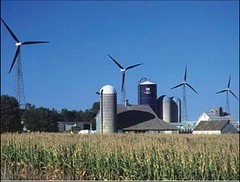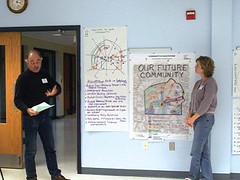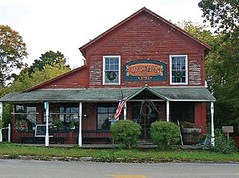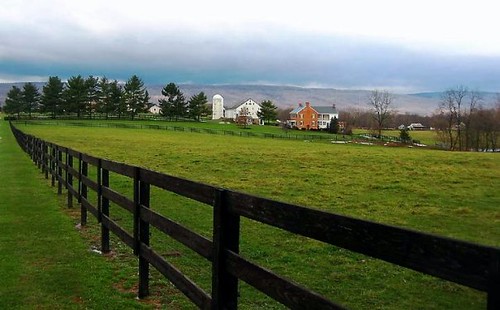Are you ready for the country? Rural communities & smart growth (conclusion)

Posted August 4, 2010 at 1:39PM
In my last post, we looked at three rural communities in Indiana, South Carolina, and California, each with character but each facing uncertainty. (The photo above shows a fourth community, Keene, New Hampshire.) The post concluded by questioning whether the principles of smart growth had relevance to small towns in non-metropolitan America.
There is certainly reason to hope that there are good principles and resources upon which we can draw to maintain and strengthen rural sustainability. According to the International City/County Management Association (ICMA), rural areas claim 75% of our country’s land area and host 49 million residents. While the issues they face can be very different from those confronting our growing suburbs and our cities, these areas supply much of our food, fiber and natural resources, along with important environmental assets such as watersheds, wilderness, and wildlife habitat.
There is also a sort of spiritual connection that many Americans feel toward small-town America and the rural landscape, given our country’s agrarian roots. Many of us who are now committed city dwellers are only a generation or three removed from the farms and small towns of our forebears; those farms and towns continue to support a way of life that instills pride in their residents. In this blog, I've quoted extensively my friends Lee Epstein and Steve Davis on the things they have experienced and loved about small-town and small-city life, respectively.
But, as we saw in Fulton, Chesnee and Yreka, many rural communities are experiencing declining employment, shrinking populations, poverty, and increased numbers of vacant properties. Moreover, many rural landowners are now elderly or close to it. As a result, there will be a transfer of farms, forests, and resource lands of significant proportion in the coming decades.  The principles of smart placemaking and conservation would seem to apply as a way of protecting what is important in these places as they evolve, but a threshold question might be, “does smart growth require growth to be effective?” To date, most of our examples of exemplary smart growth have involved shaping new development activity, whether in a revitalizing city neighborhood or a suburb that needs to build more sustainably. The challenge facing small towns may be how to retain and attract residents more than how to manage an influx of new ones.
The principles of smart placemaking and conservation would seem to apply as a way of protecting what is important in these places as they evolve, but a threshold question might be, “does smart growth require growth to be effective?” To date, most of our examples of exemplary smart growth have involved shaping new development activity, whether in a revitalizing city neighborhood or a suburb that needs to build more sustainably. The challenge facing small towns may be how to retain and attract residents more than how to manage an influx of new ones.
ICMA’s new publication, Putting Smart Growth to Work in Rural Communities, seeks to provide some answers and guidance. The report, which was developed under a cooperative agreement with the US Environmental Protection Agency and published under the auspices of the Smart Growth Network, begins by noting that not all rural communities share the same characteristics: a varied typology might include, for example, gateway communities to natural resource and tourist areas (e.g., Yreka), resource-dependent communities (Fulton, clearly a farm town), Main Street communities (perhaps Chesnee, once), edge communities in the path of sprawl (see discussion of Baldwin, Minnesota, here), and second-home and retirement communities.
But they do share some of the same challenges, including farm consolidation leading to fewer farms and farmers, loss of forests and other resource land to sprawl, shrinking populations, lack of convenient access to services, and very limited planning capacity. ICMA identifies helpful approaches that fall under three distinct but interdependent goals:
- Support the rural landscape by creating an economic climate that enhances the viability of working lands and conserves natural lands;
- Help existing places thrive by taking care of assets and investments such as downtowns, Main Streets, existing infrastructure, and places that the community values; and
- Create great new places by building vibrant, enduring neighborhoods and communities that people, especially young people, don’t want to leave.
Those sound right to me, though achieving them is far from straightforward or easy.
The report recommends a number of policy tools for supporting an economically viable rural landscape, from farm-supportive tax policies to the use of transfer/purchase of  development rights and conservation easements to keep land available for rural uses in the long run, along with demand-side measures such as urban farmers’ markets, “buy local” campaigns and “agritourism.” One especially intriguing recommendation is the adoption of programs to support renewable energy production on farmland (Fulton County’s website lists two farms there that have begun to produce wind energy). In addition to wind and solar, biomass energy production is another innovative way for agricultural land to produce income.
development rights and conservation easements to keep land available for rural uses in the long run, along with demand-side measures such as urban farmers’ markets, “buy local” campaigns and “agritourism.” One especially intriguing recommendation is the adoption of programs to support renewable energy production on farmland (Fulton County’s website lists two farms there that have begun to produce wind energy). In addition to wind and solar, biomass energy production is another innovative way for agricultural land to produce income.
Another environmentally beneficial way to generate income from rural land is an emerging model for market trading of “ecosystem services.” The report explains, citing an example from New York:
“In an ecosystem service market, the landowner sells ecosystem service credits to a bank, which in turn sells them to a buyer that has exceeded limits in carbon emissions, water pollutants, or biodiversity loss, based on a cap and trade system. Ecosystem services markets allow landowners to capture the value of the ecological benefits their land provides to the public. One of the best examples of this approach is in New York’s Catskill Mountains: New York City provides payment for ecosystem services in order to protect its drinking water supply, ensuring that the land in the watershed will not be developed.”
The second goal - helping existing places take care of their assets - is supported with a number of recommendations for maximizing the benefits of historic resources, existing town center infrastructure, Main Streets with the potential for revival, and older schools. These ideas and more are illustrated with examples such as streetscape improvements in Victor, Idaho, financial support and downtown refurbishments to attract start-up businesses in Swainsboro, Georgia, and a rural heritage program in Kentucky.
The part of the report that will be most familiar to smart growth advocates is the set of recommendations under the third goal of “creating great new places,” through infill and compact, walkable, and contiguous development. (See a particularly creative and appealing example from this blog in Langley, Washington, population 959.) Context-sensitive design and green streets, along with parks, are also part of the strategy. Again, there are some good examples but, in the interest of keeping this post to a manageable length, I won’t delve into them. One thing that I would like to see in a future edition is a discussion of the issue of scale: I have seen too many development proposals that would double (or more) the size of existing small towns. No matter how great the design, that can make sustaining rural character difficult.
 The report concludes with an excellent discussion about process, recommending an assessment of current conditions and a collaborative visioning process as predicates to establishing policies that will help the community realize the shared vision. Albemarle County, Virginia, is cited as a successful model, and I might add Lancaster County, Pennsylvania as another.
The report concludes with an excellent discussion about process, recommending an assessment of current conditions and a collaborative visioning process as predicates to establishing policies that will help the community realize the shared vision. Albemarle County, Virginia, is cited as a successful model, and I might add Lancaster County, Pennsylvania as another.
Putting Smart Growth to Work is a great introductory resource to help rural communities and sustainability thinkers kick off a discussion we very much need to have. You may download the full report here. And congratulations to ICMA and EPA for bringing it to us.
For reference, I would like to mention a few additional favorite resources (not necessarily the most representative or the very best on these subjects, just ones that I know and like a lot) that are relevant to rural sustainability and placemaking:
- Strong Towns and the Strong Towns Blog
- American Farmland Trust
- “Life After Sambo” (Alabama’s Rural Studio, Metropolis Magazine)
- Orton Family Foundation
- National Main Street Center
Finally, because my readers deserve a treat from time to time, and because this is my blog and I can, I leave you with the inspiration for the title of this miniseries. The video quality is terrible, unfortunately, and the sound could be better, too, but the music is fantastic. Here’s a youthful Neil Young and the late, great and sorely missed Waylon Jennings together on Neil’s song, “Are You Ready for the Country?”
Move your cursor over the images for credit information.




